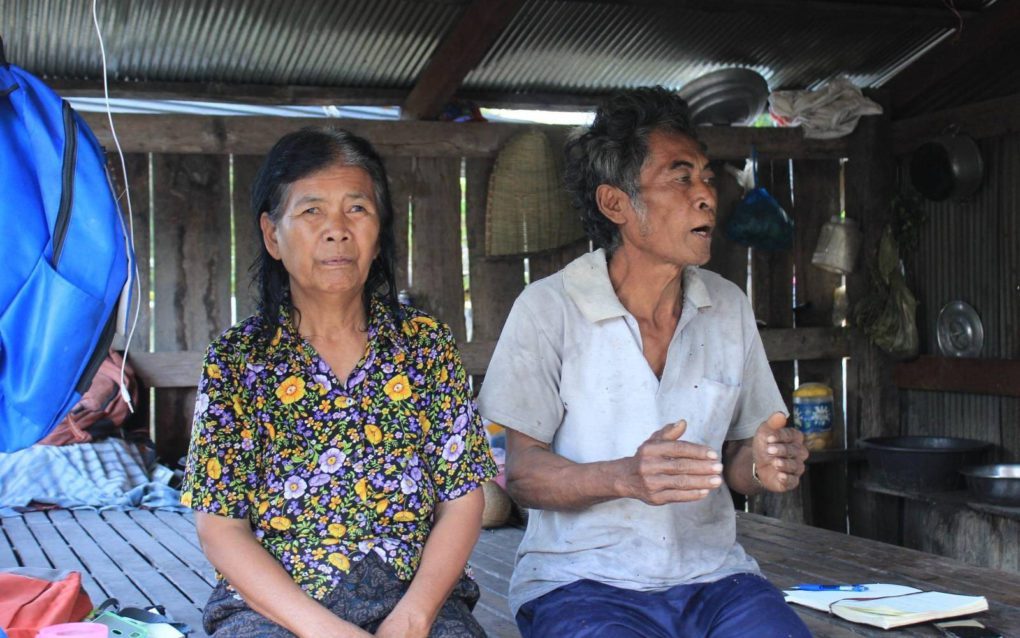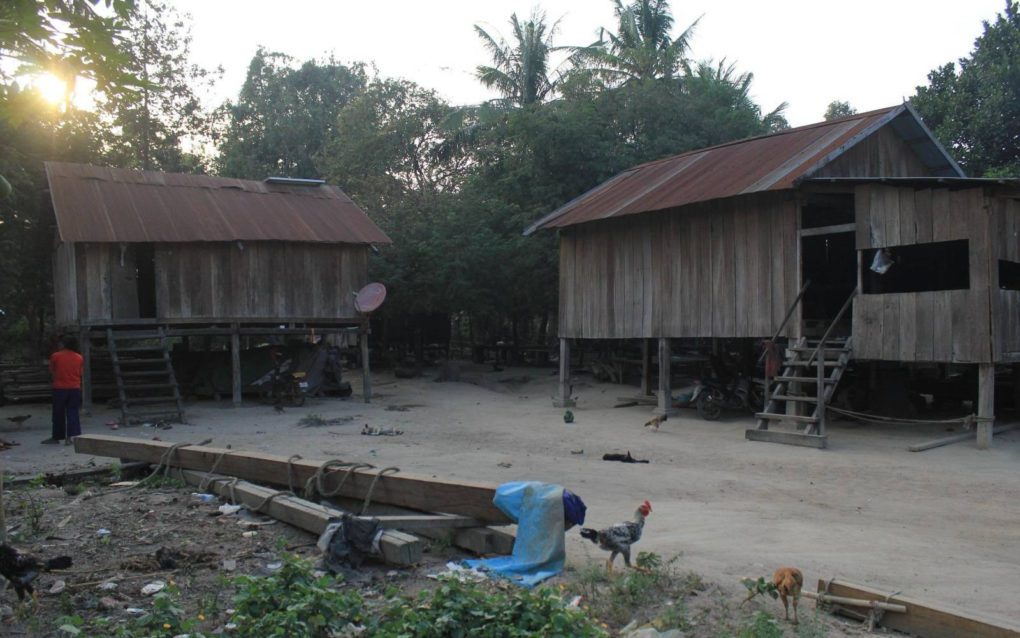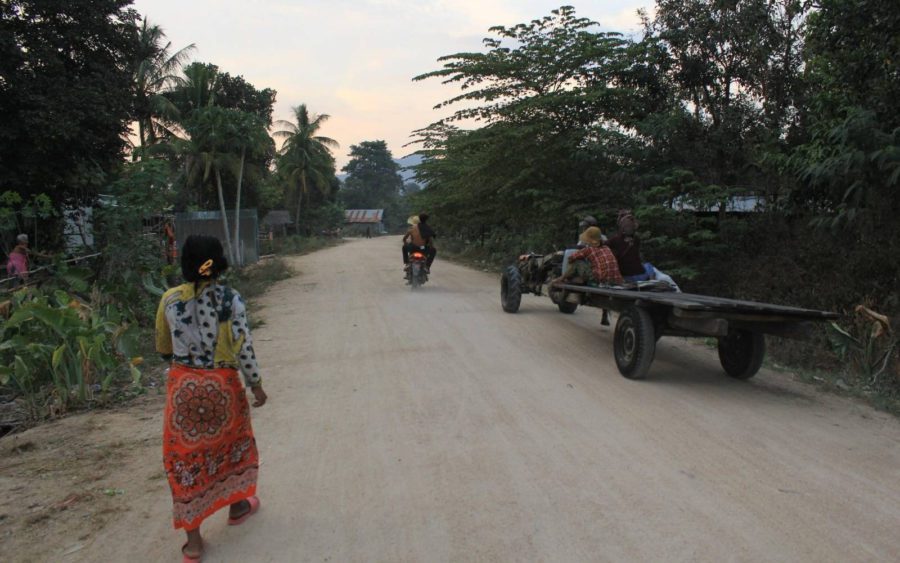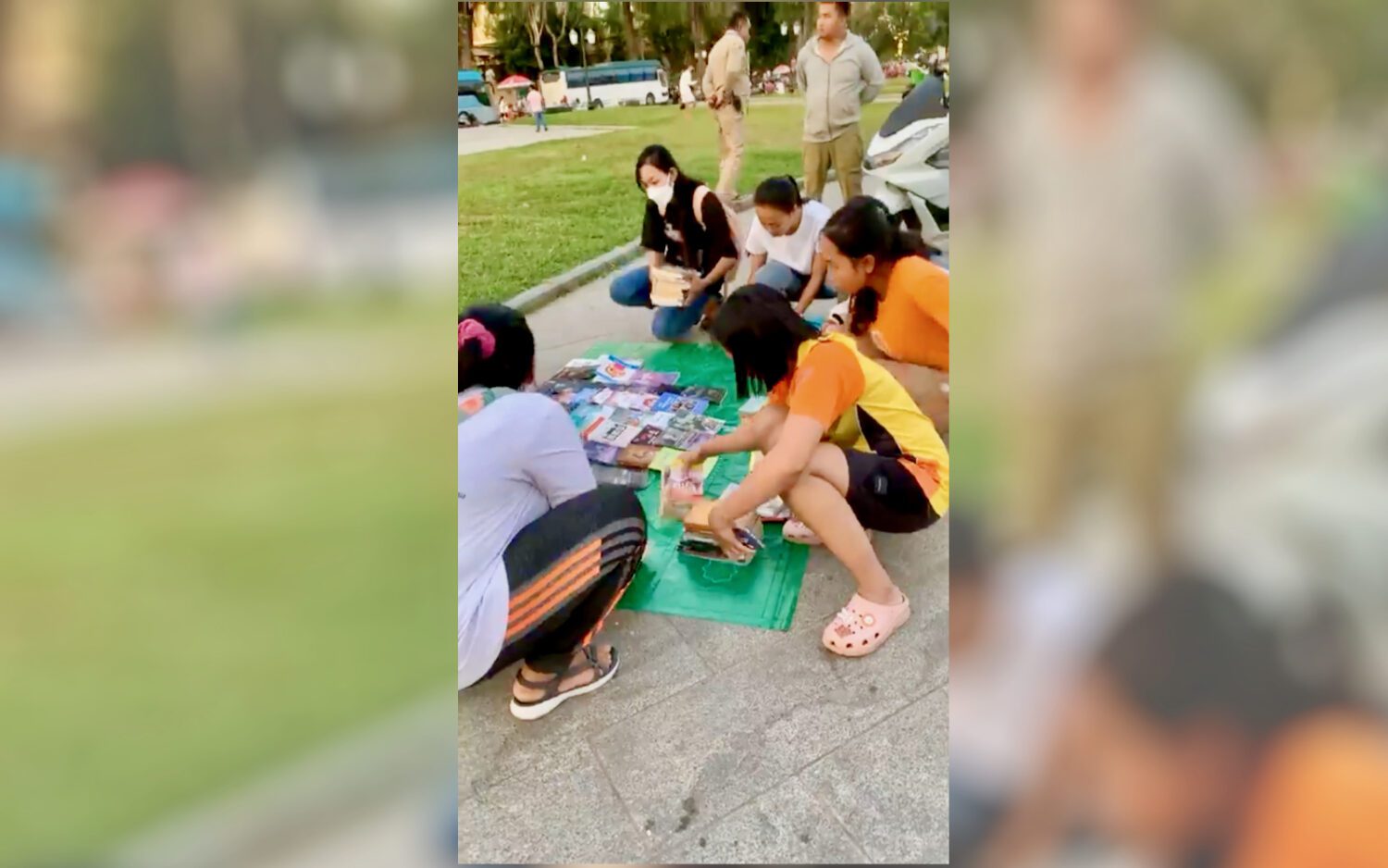As the sun sets above the isolated village of Sre Ken, set in the rugged Oral district of Kampong Speu, the mountains that rise above on all sides fade to a soft purple before disappearing in the night.
It was on a dim evening here that Pleng Komsot, whose family says is about 18 years old, is alleged to have murdered his stepfather, Srey Vath. A provincial deputy police chief confirmed Komsot was arrested two days after the January 10 killing. The young man now stands accused of premeditated murder after he confessed to hacking at Vath with a knife until his stepfather died, collapsing in the dirt outside a neighboring home. To explain why he’d done such a thing, Komsot accused Vath of being a sorcerer, of using black magic to harm others.
On a recent visit to Sre Ken, reporters from VOD found that many other residents had also believed Vath to be a sorcerer.
Even if they felt it, none who spoke with reporters expressed any sympathy for the dead man — not even a former drinking partner, who said he had experienced serious stomach pains that he claimed were due to the effects of one of Vath’s curses. Even after the murder, the villager said his one-time friend still came to see him.
“When I sleep, I dream about his spirit,” he said, declining to give his name when asked. “It comes to suppress me.”
Accusations of witchcraft can be taken very seriously in parts of Cambodia. That’s especially so within rural hamlets such as Sre Ken, ringed by mountains and reachable only by a deeply rutted dirt road, crossed at various points by streams.
In places like this, killings related to sorcery claims are not uncommon. But this year may already be shaping up as an especially violent one, particularly with the brutal slaying on February 1 of five members of a Mondulkiri family of indigenous Bunong, including two 5-year-old children and a teenager, whose killers claimed to believe were sorcerers. That attack also left a 12-year-old boy seriously injured.
While the authors of a 2019 report from the U.N. OHCHR on so-called “popular justice” found no official statistics on witchcraft-related violence, they did learn of 49 cases of such that happened between 2012 and 2018. As described by local police and provincial court authorities, 35 of these events involved killings, while the rest were either attempted killings or harassment. The report says that in the period between January 2017 and June 2019, the Ministry of Interior noted 16 cases of mob violence and eight killings following accusations of witchcraft.
The authors of the report found distinctive patterns to these accusations, as have other anthropological attempts to understand why such murders happen in Cambodia.
“Living in remote places and villages where everybody knows everybody, living very close to each other, having these daily frustrations. … When you have repeated misfortune or disease, you need to find an explanation,” offered Fabienne Luco, a former U.N. human rights officer and an author of the 2019 report. “Sometimes the best way to find that is to look to somebody, a scapegoat that will be the recipient for all your anger and frustrations.”
Luco, who is an anthropologist by training, had studied traditional beliefs and so-called popular justice in Cambodia for more than 25 years. Though there are signs sorcery-related killings have decreased over time, she said the community approval and cooperation behind many such murders can make their numbers difficult to track.
Though the cases in Kampong Speu’s Sre Ken and more recently in Mondulkiri led to quick police responses, much of the narrative around Vath’s death, as told by villagers, closely matched the wider trends observed by previous studies.
Those who spoke to VOD said they believed Vath had, before his own death, used black magic to kill at least three other local residents who had died from unexplained illnesses. Unexplained deaths can be a common occurrence, especially given the weak medical infrastructure of rural Cambodia. But those who knew the murdered man pointed to these deaths as they weaved a story of mysterious illness, fatal curses, and advisement from a traditional Khmer healer, a kind of spiritual consultant known as a kru.

The kru can be a trusted guide in dealing with such matters across the country. Belief in spirits, benevolent or otherwise, is common in Cambodia, where the majority religion is a syncretic blend of Theravada Buddhism and local animist beliefs. Besides kru, some Buddhist monks also lend their services to mitigate suspicions of witchcraft or even conduct exorcisms for people whose families believe they are possessed by malignant entities.
But such beliefs alone don’t typically explain sorcery-related killings in Cambodia. As in many cases, the residents of Sre Ken also pointed to Vath’s alleged anti-social behavior — in this case, a history of domestic abuse that was both public and extreme.
Vath’s in-laws were among those who said they’d witnessed him beating and humiliating his wife, a woman known as Rim, who is the biological mother of the alleged murderer Komsot.
The grandparents of the accused also said they had mostly raised the young man.
“He called us mother and father,” said Mao Ran, 68, the young man’s grandmother. She explained Komsot had worked with his grandfather, her husband Phlok Phleng, 66, collecting wood in the forest to make charcoal. Ran said the young man had previously been a monk for about three years.
They said Vath would often beat their daughter Rim, hitting her about the face and head. Some witnesses said the man even stepped on her in the road, pushing her into the mud — on at least one occasion dragging her naked on the dirt road that runs through the village.
“But nobody dared to help, because everyone was scared of him — we thought he’d use sorcery to curse us,” Phleng.
For Vath’s stepson, the dragging may have been the final act of violence he could bear.
“When he was young, he’d just cry,” when he witnessed his stepfather abusing his mother, said a young woman who said she was a cousin of the young man. “But then he got older and bigger.”
As the young man’s grandparents and cousins described his character in positive terms, a passing elder monk with a small wiry beard stopped to sit and listen in. Spitting betel juice, he said he didn’t know about the sorcery claims, but said Komsot was a gentle person, an opinion he did not share for Vath. The monk offered a short explanation for the murder.
“It was karma,” he said.
Still, while the others may have agreed with that, they were firm in their belief that Vath had also been practicing witchcraft. This seemed mostly based on information they’d received from a kru in the area, who they said had treated them for symptoms believed to be caused by black magic and had advised them on what traits to look for in a possible sorcerer. Based on what the kru had said, the villagers came to believe Vath was their tormentor.
Komsot’s grandfather was one of several people who told reporters they had been cursed, most of whom described the effects as swelling and pain of the abdomen or extremities.
“[One time last year] he made me sick. I went to a kru to help, and they said I’d been cursed. But they sprayed some [holy] water on me, and I recovered,” Phleng said.
Down the road from the family compound, other villagers weighed in on the recent murder, some sharing their own beliefs that they too had been cursed.
Khun Savath, a woman minding a small shop on the village’s main road told VOD she’d witnessed Vath’s violence toward his wife, including when he’d dragged Rim down the dirt road. As the shopkeeper recalled the time leading up to the man’s murder, she repeatedly emphasized her sympathy for the accused killer — and her intense scorn for the murdered man.
“He never cursed anyone or attacked anyone. Nobody disliked him,” Savath said of Komsot. “But mostly we wished [Vath] would die.”
She claimed villagers had shunned the funeral of the deceased and did not pay their respects to him. On the other hand, Savath said people had collected funds for Komsot and had wept when police came to arrest him for the murder.
“Everybody, from small children up, had joined hands wishing [Vath] would die,” she said.
Savath believed people in Sre Ken had come to suspect sorcery about five years ago. She said one villager then whose stomach had swelled had gone to Calmette Hospital in Phnom Penh and could not be treated, even with medicine.
As in other countries, frustration or mistrust in more mainstream medical practices can push Cambodians to seek alternative forms of treatment. This can help the bustling trade for services of kru, some of which can be seen in action on social media.
A kru who practices under the name Charb Kru Aong Kam, who works from the Boeng Preas district of Prey Veng province, told VOD by phone that witchcraft is common in Cambodia — at least based on what he’s seen from a regular stream of clients complaining of the effects of what they believe to be black magic.
“Symptoms of people who have been cursed are vomiting, inability to sleep or eat well, dreaming about a big person trying to catch them, or snakes trying to kill you,” he said, adding that his clients may also say they experience shaking in the hands or legs.
“The most dangerous witchcraft is the Burma type of black magic,” the kru continued. “After this is [that of] the Cham and Kampuchea Krom. For this kind of curse, I charge $100 per case.”
Charb Kru Aong Kam said sorcery is widespread in the country, even providing a list of the six-most affected provinces: Kampong Cham took the top place, he said, with Kampong Speu ranking in sixth.
The kru mentioned Mondulkiri at the end, almost as an aside. However, the sparsely populated, largely indigenous province is typically seen as a main region for Cambodian sorcery beliefs.
It was there that police two weeks ago in the Me Pai village of Pech Chreada district reported a brutal crime against the Bunong family, eventually confirming the murder of five people. According to reported testimony from the accused murderers, a group of six men who knew the victims, the family members had been bludgeoned and stabbed to death in a home.

Local officials reached by VOD said there was no sorcery in the village and said they didn’t know why the suspects had killed the family. Though the killings happened in the more rural Pech Chreada, the family lived for most of the time in Lauka village, according to the village chief Kim Sin. Lauka is much closer to Sen Monorom city, the largest town in the province.
Klok Phyrom, a villager from Lauka, said the murdered family had farmed in Pech Chreada district. Phyrom said Lauka had been peaceful before the slayings, with no accusations of black magic. Unlike other cases of murder that involve sorcery claims, in which villagers may approve of killings of alleged witches, Phyrom said she was unsettled by the violence.
“After this crime happened, I’m very worried, and I don’t know what the authorities will do about this,” she said.
Phyrom suspected illegal drug use may have had something to do with the murders and questioned the motives of the group of accused killers, adding that some of the suspects had even joined other villagers to look for bodies of the victims who had initially been missing from the scene.
Investigating police have rejected drug use as a factor in the crimes and have stood by sorcery beliefs as the key motivation, stating that the suspects have confessed to that.
Sorcery-related violence does not always lend itself to a full criminal investigation in Cambodia, said Luco, the former U.N. rights official.
“Police say it’s hard to investigate because most of the village has usually agreed about the killing,” she said. “Nobody wants to speak to [police] and [they] will face strong resistance from the rest of the population, which is happy the alleged witch is killed.”
That kind of sentiment makes victims of a wide band of Cambodian society, argues historian Sambo Manara, who is a professor at Pannasastra University. From ancient origins, he said, the folktales at the heart of sorcery beliefs have become woven into a toxic modern culture with no basis on scientific fact.
Both the killers and their prey in witchcraft-related killings “are all victims of the wrong kind of education from society,” Manara said.
“This causes people to live with each other without peace and prosperity, and so we must create new education through science that gives clear explanations that there are no such phenomenons,” he said.
For now, accused sorcerers are often those who stand out from other community members — for whatever reason, they are seen as not conforming to the norms of their village. Luco said this can often just be for basic personal quirks, but may also include things others see as more serious moral failings, as in the case of Vath’s alleged domestic violence.
Echoing Manara’s cry for better science, Luco explained the symptoms of sorcery are “usually a kind of disease that the doctors cannot explain or name, or that the local healers cannot cure.”
If a kru thinks a condition is out of their ability to address, they may tell their patient the malady is so strong that it must be coming from a sorcerer.
“Sometimes they give a [general] description of a person, but we found sometimes they gave a specific name,” Luco said, adding that this name is often that of the hated village standout. “[The killing] is then like the performance of a ritual, like a sacrifice. You’ll sacrifice someone from your own community for the alleged curse to go away, for peace to come to the village.”
In the case of Vath, it’s unclear what specific information the kru gave villagers that led them to suspect sorcery. Still, while some said they were still uneasy after the murder, others said it indeed felt as if a cloud had lifted from Sre Ken.
For Savath, the shopkeeper with harsh words for the deceased, whatever ritualistic element of the killing had seemed to do its job.
“Before, we lived with our eyes on the backs of our heads,” she said. “Now, things are getting better, we have peace.”
Additional reporting by Mam Sampichida












